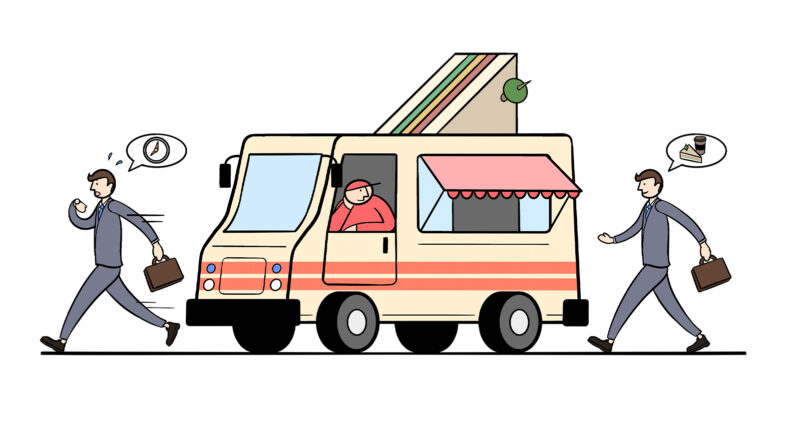How Humans Switch between Information Seeking and Encountering
How Humans Switch between Information Seeking and Encountering
Tingting Jiang, Shiting Fu, Sanda Erdelez, Qian Guo
Have you ever encountered a mobile food cart on your way to work? Suppose you don’t have breakfast. You will probably stop and buy a sandwich and a cup of coffee. What if you are running late for work? You will probably keep on walking and ignore the food cart instead. That is, an urgent goal beats serendipity.
Similar phenomena are common during online information acquisition. When you search for some information you need, it is possible that the search engine returns a less relevant result item that happens to satisfy another need. To view or not to view the item? We investigated users’ dilemma as the “seeking-encountering tension.”
—An urgent goal beats serendipity—
Information seeking (IS) and information encountering (IE) are the two major modes of information acquisition. IS features the active behavior of looking for information in response to the current information need. In contrast, IE refers to an individual capturing unexpected information that has the potential to address a need not being actively pursued as it passes by. As distinguished in terms of involvement, IS and IE are triggered by foreground and background tasks, respectively.
The tension between IS and IE has been recognized in previous studies: an information seeker might be enticed by an unexpected stimulus to examine the associated content in detail, thus turning into an information encounterer; since the IE activity engenders both opportunities for new insights and risks of wasting time and effort, the individual might be pulled back to the safety of the suspended IS activity to ensure the explicit goal (Erdelez & Makri, 2020; Makri & Buckley, 2019; Waugh, Mckay, & Makri, 2017).
With an aim to understand the mechanism of the seeking-encountering tension, we conducted a controlled experiment on a sample of 39 participants. Our focus was on the roles of task urgency played in such tension. Task urgency has been identified as a major factor affecting IS processes and outcomes, as well as a determinant of the likelihood of IE occurring.
For the purpose of creating a real-world IS scenario, we recruited the participants in the name of a search study in which they were asked to complete 6 search tasks about the biography of movie director George Miller. As the participants all enrolled in the User Experience Design course, we gave them a course assignment about Miller’s Law contributed by psychologist George Miller, prior to the search study, to engender an on-going need to be satisfied.
In the experiment, we used the search tasks as foreground tasks to trigger IS and the course assignment as a background task to trigger IE, respectively. An implicit connection was built between them in virtue of the homonym. The urgency of both types of tasks were manipulated in terms of two levels, i.e., high and low.

We constructed a mock search engine and deliberately embedded the result items related to the psychologist on the search result pages returned for the queries related to the movie director. This enabled eliciting IE during the process of IS. Our experiment employed an eye tracker and a screen recorder to capture the participants’ eye movements and clicking behavior when they performed the search tasks in the laboratory.
As reported in our recent IP&M paper, we successfully observed the seeking-encountering tension and obtained two important findings:
First, the seeking-encountering tension led to a lose-lose consequence. The tension actually featured the persistent competition between IS and IE for users’ attention and actions. On the one hand, the presence of the psychologist-related result items caused distraction from the searching for director-related information, including more dispersed distribution of attention and more frequent query reformulation and result examination. On the other hand, despite the encountering of the unexpected irrelevant result items, users would quickly return to searching and thus fail to remember the encountered information.
Second, task urgency was a key force in the seeking-encountering tension. As predicted, the increased foreground (search) task urgency accelerated the search processes and enhanced users’ selectivity; and when the background (assignment) task urgency was high, users devoted greater efforts to examining the encountered information. An interesting result of analysis is related to the switching from IS to IE. The higher the foreground (search) task urgency, the more difficult the switching. Contrarily, lower time pressure in the foreground was conducive to reviving a background need and processing incidental cues.
Our study of the seeking-encountering tension enriches the understanding of multitasking in human information acquisition and generates a fresh perspective on the interplay between different types of information behavior. It is necessary to avoid task competition and make users stay focused on one task at a time instead of bouncing between IS and IE. The design of tension-free search systems should consider users’ task attributes and be adaptive to their desire for relevance versus serendipity.
The original article: Jiang, T., Fu, S., Erdelez, S., & Guo, Q. (2022). Understanding the seeking-encountering tension: Roles of foreground and background task urgency. Information Processing & Management, 59(3), 102910.
References
Erdelez, S., & Makri, S. (2020). Information encountering re-encountered: A conceptual re-examination of serendipity in the context of information acquisition. Journal of Documentation, 76(3), 731-751.
Makri, S., & Buckley, L. (2019). Down the rabbit hole: Investigating disruption of the information encountering process. Journal of the Association for Information Science and Technology, 71(2), 127-142.
Waugh, S., Mckay, D., & Makri, S. (2017). ‘Too Much Serendipity’:The Tension between Information Seeking and Encountering at the Library Shelves. Paper presented at the CHIIR 2017
Cite this article in APA as: Erdelez, S., Fu, S., Guo, Q., & Jiang, T. (2022, April 22). How humans switch between information seeking and encountering. Information Matters, Vol. 2, Issue 4. https://informationmatters.org/2022/04/how-humans-switch-between-information-seeking-and-encountering/





